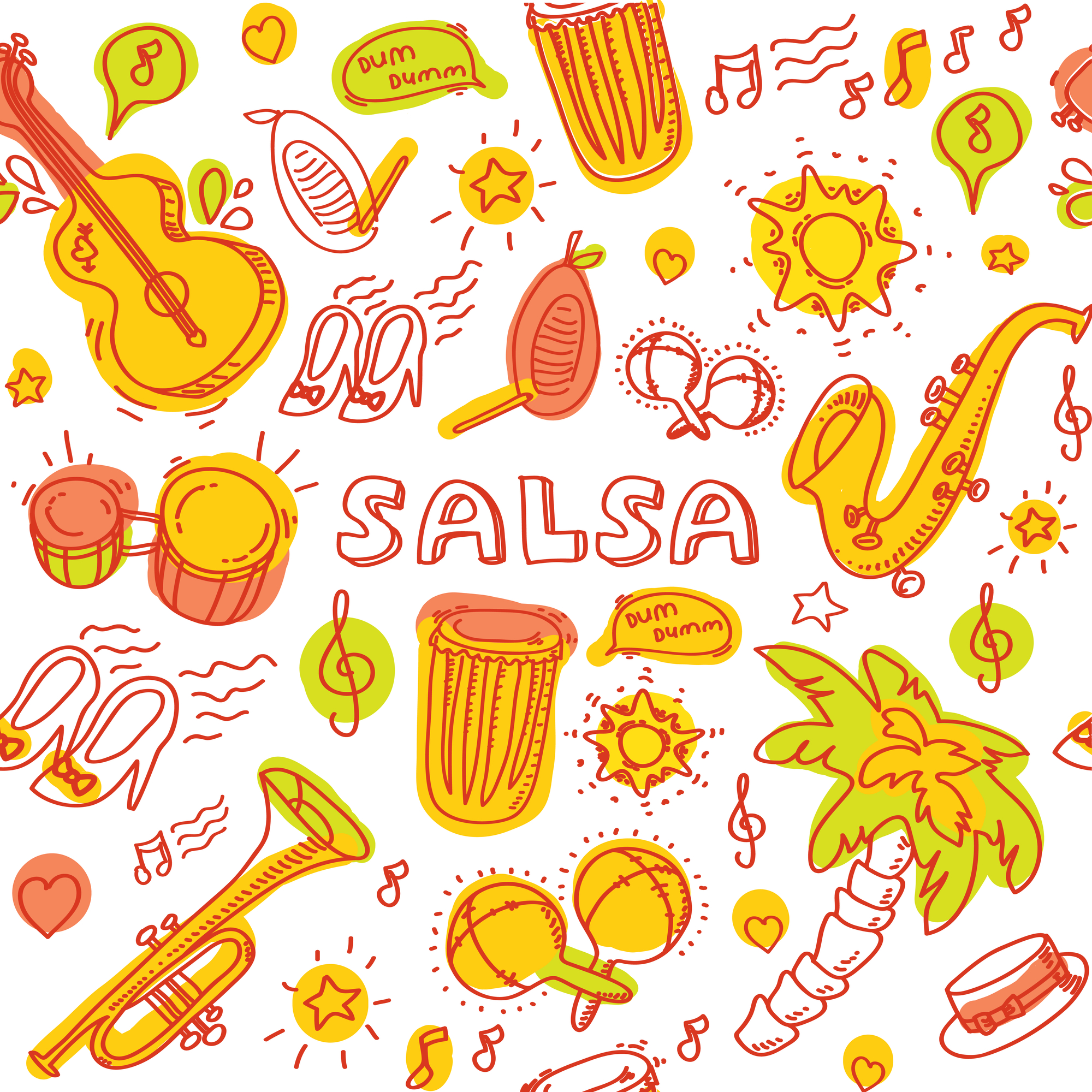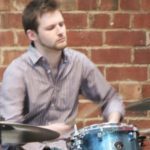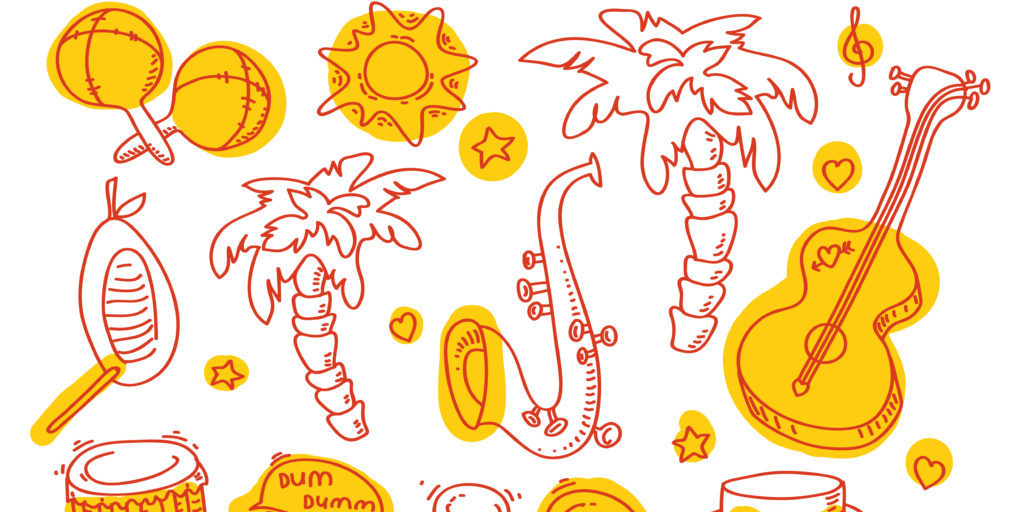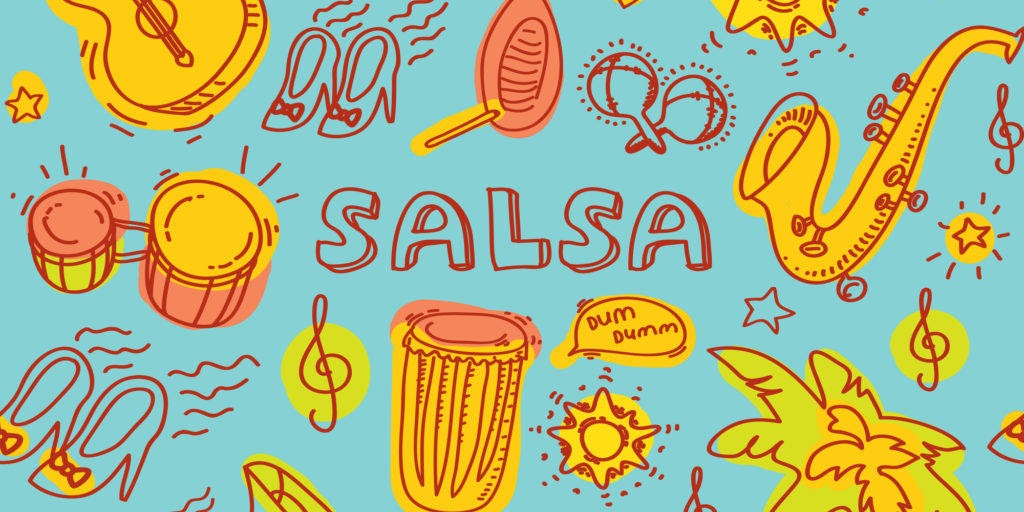Now that we have a basic understanding of the history of salsa music, we will take a more practical approach to how it is played.
We will trace the roots of salsa back to its son origins, looking at the fundamental salsa rhythms that came from this more folkloric Cuban style, before discussing how and when the style became popular.
We’ll also discuss how the drum kit can be incorporated into a style of music in which it isn’t traditionally played.
Salsa and its Son Rhythmic Foundations
Salsa has many similarities with Cuban son music.
In fact, the relationship between these styles can be compared to the relationship between jazz and dixieland. The former came first and laid the foundations for the latter (a new and more modern sounding style) to gain international success.
Below are some of the fundamental rhythms and patterns used in salsa that have origins in Afro-Cuban music such as son and rumba. These rhythms are the basic building blocks of salsa music. All of the following rhythms have been notated in 2:3 direction.
1. Clave - salsa music is usually centred around the son clave, while the direction is usually 2:3, meaning that the bar with 2 notes comes first, followed by the bar consisting of 3 notes.

2. Cascara - The cascara is effectively an embellishment of the clave, and is usually played on the cascara (shell) of the timbal.

3. Bass tumbao - The bass line most commonly played in son music is called tumbao, the bassist anticipates each chord change by playing the root note of each chord either 1 quarter-note beat, or an 8th-note beat before the pianist.

4. Montuno - In son music, the pianist or tres (Cuban stringed instrument consisting of 3 pairs of strings) player plays a highly syncopated pattern called a montuno. While the tres is rare in salsa music, piano is a staple of the salsa ensemble and the pianist will play a montuno during certain sections of a salsa song.

5. Martillo - In son music the bongocero (bongo player) plays a driving quarter note rhythm called martillo (hammer). This is also a staple of the salsa percussion section and the martillo rhythm is played in a similar way to how it’s played in son.

6. Conga tumbao/marcha - The conguero in son music plays an 8th-note pattern called a tumbao (in Cuba) or a marcha (everywhere else).

The conguero usually has 2 drums, the conga and the tumba. The conga is smaller and is the most important in playing the tumbao pattern, while the tumba outlines the “3” side of the clave pattern.


7. Bongo bell - For the latter sections of son songs, the bongocero often switches to a handheld cowbell called the campana de bongo (bongo bell). In salsa music, the inclusion of the timbalero (timbal player) often negates the necessity for the bongocero to switch between bongos and cowbell, which helps to create a denser percussion section during bigger moments of the song.

Salsa Anatomy
Salsa music usually follows a fairly rigid song structure that’s important to understand, especially for percussionists, as what we play will vary depending on the section being played. Following is an example of a common salsa song structure, and what the percussion section will usually play in each section:
- Intro - the intro of a salsa song is usually a big moment and features a horn melody. It will typically end with some band hits (the whole band playing a specific rhythm together) leading into the verse.
- Congas - the conga pattern tends to remain the same throughout a salsa song. A common variation is to play a tumbao with just one conga during the verse and add the tumba (lower conga) during the chorus, coro, and mambo sections. The intro tends to be played over two congas.
- Bongos - The bongocero tends to play the bongo bell during the intro to make a big impact right away. If the timbales player also uses cowbells, this might not be necessary and the bongo player can continue playing bongos.
- Timbales - The timbalero will either play the cowbell or cascara depending on what the rest of the percussion section is doing. If the bongocero isn’t using a cowbell, then it’s the role of the timbalero to do so here. On the other hand, if the bongocero is using a cowbell, then the timbalero will play cascara instead. After the band hits at the end of this section, it’s common for the timbales to play an abanico (a stylistic timbales fill) into the verse.

- Verse - the verse, just like in a rock or pop song, is where the singer enters. If horns play, it will usually be to embellish the harmony, add counter melodies, or provide rhythmic interest for the percussion section to interact with.
- Congas - In the verse, the congero will commonly play using just one conga. The conga tumbao will sometimes be simplified to reduce the density of the groove.

- Bongos - If the bongocero is using the traditional alternation between bongos and cowbell, then at this point they will switch to playing a bongo martillo. It’s common for the bongo player to play fills at the end of phrases, in between the vocal phrasing.
- Timbales - If the timbalero is playing the cowbell in the intro, then they will switch to playing cascara at this point. The left hand can either be used to fill in the empty 8th-note spaces in the cascara rhythm on the other side of the shell, or to play beats 2 and 4, alternating between closed and open strokes with the tips of the fingers on the drum head.
- Chorus - the chorus (not to be confused with the coro) comes after the verse and usually repeats before going back to the verse. Depending on the length of the song, the verse and chorus can repeat a number of times before moving on to the next section of the song.
- Congas - In the chorus, the congero will usually add the second conga on the 3 side of the clave.
- Bongos - The bongocero will usually continue playing the martillo during this section.
- Timbales - The timbalero will usually continue playing the cascara during this section. In certain songs a cowbell might be necessary in the chorus and this could be played by either the bongocero or timbalero.
- Coro/pregon - the coro forms the main body of a salsa tune and is usually a 4- or 8-bar harmonic vamp. Once the song reaches this point, it usually cycles around this chord progression for the remainder of the song until the end, which is usually a refrain of the intro. The coro features a catchy vocal hook that is sung by a group of backing singers, or the rest of the instrumentalists while the pregon is similar to a “rap,” though not as busy rhythmically, where the lead singer improvises some melodic content and lyrics in between the backing vocal phrases. This section is also identifiable by the prevalence of the piano montuno, a syncopated harmonic device in which the piano (or tres in traditional Cuban son) plays arpeggios, usually with octaves in the right hand.
- Congas - The congas will continue playing a tumbao on 2 congas here but greater energy can be created by adding fills at the end of phrases. The congero will usually play the tumbao in this way for the remainder of the song
- Bongos - The bongo player will usually switch to cowbell here to create greater energy. Once the bongo bell is established in the coro, it’s unlikely that the bongocero will switch back to playing martillo for the duration of the tune.
- Timbales - The timbalero will switch to a mambo bell at this point (or bongo bell if the band has no bongero). The mambo bell will continue into the mambo section.

- Mambo - the mambo section is usually played over the same harmony as the coro but is characterised by a repetitive horn melody.
- Congas - tumbao (2 drums)
- Bongos - bongo bell
- Timbales - mambo bell
- Solos - in certain settings, it’s common for instrumentalists to solo over the chord changes established in the coro/pregon.
- Congas - tumbao (2 drums)
- Bongos - bongo bell
- Timbales - mambo bell/cascara
- Short coro - as many salsa songs reach their climax and conclusion, the coro will be reduced to half the length, without pregon in between; this section is called a short coro and builds the intensity of the song ready for a big ending.
- Congas - tumbao (2 drums)
- Bongos - bongo bell
- Timbales - mambo bell/cascara
- Ending - the end of a salsa song tends to be a refrain of the intro and it’s common to end with some band hits.
- Congas - tumbao (2 drums)
- Bongos - bongo bell
- Timbales - cascara
Salsa commonly borrows from many varying influences and incorporates them in different sections in the same song. A great example of this is “Plastico” by Ruben Blades and Willie Colón. The intro of the song features a disco groove on drum kit with bass guitar octaves and string harmony. When the verse starts, the style switches to a son montuno (a style of son music driven by a montuno on either the tres or the piano) with a bongo martillo, conga marcha, bass tumbao, and horn backings. The verse then switches to a cycle of fifths under which the percussion section plays a Puerto Rican bomba sica groove (see notation below) before returning to the son montuno after 8 bars. This song epitomises the flavour of salsa music - a fusion of so many different styles of music. The idea of switching to other traditional Latin-American grooves or styles for a specific section of a song is a feature of salsa music and the above is just one example. For this reason, when studying salsa it’s important for us to also learn and understand a broad range of Latin American folkloric styles.

Learn with LPM
The Drum Kit, Songo, Timba and Salsa
Now let’s look at a very brief history of the drum kit’s use in Afro-Cuban music and salsa.
Songo
There is one man who has had a greater impact than perhaps anyone else in the field of Afro-Cuban drum kit playing: Jose Luis Quintana AKA “Changuito.” No discussion on salsa or Afro-Cuban drumming is complete without the mention of Changuito.
He was the percussionist in the innovative Cuban band led by Juan Formell, called Los Van Van, and Changuito invented songo, a rhythm specifically designed for the drum kit. Prior to songo, the drum kit played a minimal role in Cuban inspired musical styles, and the role of the drummer was usually to approximate the rhythms and timbres created by a standard salsa percussion section consisting of congas, bongos, and timbales. Changuito broke this mould and in inventing songo, came up with a rhythm that put greater emphasis on the drummer.
While songo is in itself a unique musical style, the songo drum groove is a pattern that can be played when playing salsa music and is a rhythm that every aspiring Latin drummer should have at their disposal. To go into greater detail about songo would take an article in itself, but for now, let’s just look at how a songo groove looks written down.

Notice that this groove is a linear pattern (meaning that no two notes are played at the same time) and it brings together important elements of a salsa percussion ensemble into one pattern. The right hand plays half notes in a similar way to the bongo bell in salsa music while the bass drum outlines a tumbao.
Timba
When salsa music began to gain popularity in Cuba, there was an emergence of new Cuban bands who incorporated the drum kit into their setup and began playing more pop, rock, and funk influenced salsa music. This new style became known as timba and was made popular by bands such as N.G. La Banda. Unlike salsa, timba placed more emphasis on the rhythmic elements of North American popular music such as the backbeat.
Drummers like Calixto Oviedo began playing traditional Cuban rhythms used in salsa such as cascara, clave, and tumbao, but started adding snare drum backbeats like so:

Salsa
While it’s important to know and understand the above patterns, when playing salsa on the drum kit in a more traditional context, your main role will be approximating rhythms played by the percussion section. The table below outlines how this can be done.
| Percussion | Drum kit |
| Conga (open tone, high) | Hi-tom |
| Congas (open tone, low) | Mid/low-tom |
| Congas (slap tone) | Snare drum (cross stick) |
| Cowbell | Cymbal bell, or cowbell if available |
| Timbales (cascara) | Low-tom shell, or hi-hats |
| Timbales (open stroke) | Snare drum (snares off) |
| Timbales (rimshot) | Snare drum rimshot (snares off) |
| Clave | Snare drum (cross stick), or block if available |
| Guiro (for slower tempos such as chachacha) | Hi-hat (foot pedal to produce open and closed tones) |
Final Thoughts
When learning any style of music, it’s essential to completely immerse yourself in it. That means listening to the music itself, learning about the history of the style and in the case of salsa drumming, learning the percussion instruments from which these instruments originate. I’d absolutely recommend investing in a pair of congas, bongos, or timbales if you’re serious about learning this music. Think of it as an investment as you may well be using these instruments for gigs in the future and they will help give you a greater understanding of this music.
I hope that this article, brief though it is, in combination with the video lessons in my upcoming drum module will give you a good introduction into the style and lead you in the right direction should you want to pursue salsa music any further.
About the Author: Brendan Bache
Brendan has been in love with the drum kit since the age of 8. His love for music spans many musical genres but his great passion is the study and performance Latin American music. This interest has led Brendan to study many Latin percussion instruments such as congas and bongos as well applying these rhythms to the drum kit. Brendan is the drum kit teacher at Liberty Park Music. Check out his drum kit courses!





